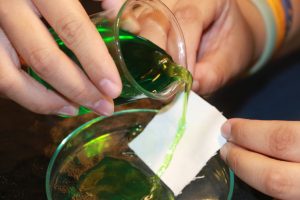Face masks have emerged as an indispensable item in the post-COVID-19 era, prompting two fourth-year physics students from the Faculty of Science to develop a water-repellent coating derived from an agricultural byproduct to enhance the properties of fabric face masks. The coating can be sprayed onto various types of fabric to prevent droplets or secretions containing COVID-19 virus particles from penetrating the fabric. Fabric masks coated with this spray can be washed and reused multiple times.

Elaborating on the origin of this project, Wipada Jarupongjitrat explains, “When COVID-19 initially emerged, there was a shortage of surgical masks, so people turned to fabric masks. However, fabric masks cannot provide 100% protection against the virus because droplets from coughing or sneezing can seep into the fabric. Consequently, we sought to develop a coating capable of preventing liquid absorption into the fabric.”

Sadanan Suknit further highlights the distinctive aspect of their creation, despite the existence of water-repellent fabric masks in the market. Their innovative coating is made from agricultural waste and can turn ordinary fabric into a water-repellent one. This approach not only contributes to waste reduction and value addition but also aligns with an environmental protection principle by utilizing natural materials.
There are various agricultural waste materials to choose from, including rice husk, sugarcane bagasse, and corn husks. Rice husk was chosen because rice is predominantly grown in Thailand, and rice husk is either turned into fertilizer or burned, with the latter contributing to air pollution. The process of making the water-repellent coating involves the following steps: extracting the desired substance from rice husk, reducing its size to the nanometer level, modifying the surface structure to become water-repellent, and then formulating it into a spray coating ready for treating any fabric. Based on their experiment, 1 kg of rice husk yields approximately 2 g of the coating.
The coating was tested on cloth diaper fabric with a relatively large pore size. Following the spray treatment, the fabric’s pore size became smaller, and water beaded up on its surface without seeping into the fabric. The fabric still maintained its water-repellent property even after 30 washes.
An advisor to the project, Asst. Prof. Dr. Kheamrutai Thamaphat, explains that the coating can be applied to an assortment of textile products such as fabric sneakers, garmets and surgical gowns, or even paper. Furthermore, the coating formulation can be tailored to suit the materials that require a water-repellent property.
For more information on this innovation, please contact KMUTT Physics Department at tel. 0 2470 8876.